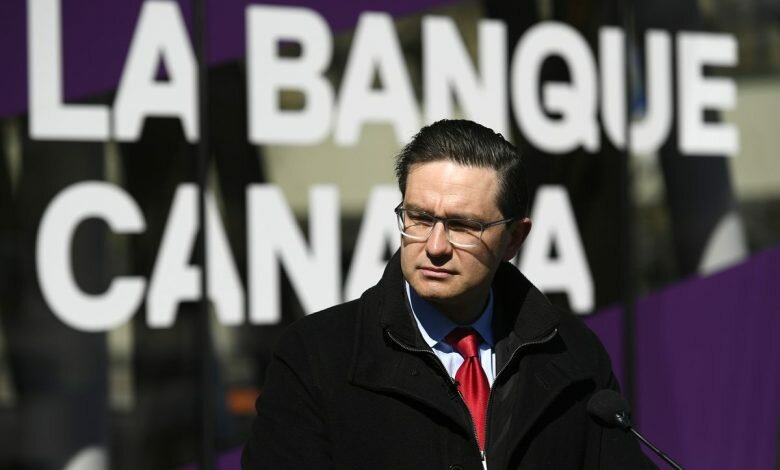Opinion: Pierre Poiliver’s Populist Bitcoin Supports Crypto Crash Signs Coming

Conservative MP and leadership candidate Pierre Poiliver speaks during a news conference outside the Bank of Canada in Ottawa on April 28. Justin Tang/The Canadian Press
I wrote in March that crypto could see a bear market. At the time, bitcoin was hovering around $40,000. As I write this, bitcoin is below $30,000. I’m sorry.
However, if we are in a true bear market, there will be more pain ahead. And there are signs that we are moving in that direction.
Among those signs, presumably, is how bitcoin has entered the conversation around the Conservative leadership race, via the staunch support of candidate Pierre Poiliver. It unfolds a long-discussed story about an outsider whose sudden interest in a particular investment sector spells doom.
Maybe Mr. Polievre is a shoeshine boy.
This perhaps-true tale of a young blue-collar activist involves investor Joe Kennedy, father of former US President John F. Kennedy. Mr. Kennedy Sr. said he had a sense of the stock market collapse of 1929 and the impending Great Depression because, one day, the guy who shone his shoes started giving him investment tips.
I personally never trust the guy who doesn’t polish his own shoes, but the Mr. Kennedy anecdote has lived on as one of those great investment anecdotes.
One such scene is in The Big Short, a film based on a non-fiction book. of the same name. A character based on investor Steve Eiseman expresses his conviction about a bursting housing bubble, when a stripper tells him he has six hefty mortgages.
What are the stablecoins, the assets that rock the cryptocurrency market?
Crypto Meltdown Deepens as Stablecoin Tether Falls Below the Dollar Peg
Which brings us to Mr. Polievre. He is an educated man and a finance critic of his party, and clearly knows what he is talking about. But that was never questioned, and it’s not about him.
The moral of the shoeshine boy story is not about the specific kid and whether he had any business giving Mr. Kennedy stock tips. After all, we shouldn’t dismiss the boy’s skill just because of his profession. The point is the trend the boy represents.
If you meet a shoeshine guy who’s in stock, chances are you haven’t met the only one in the whole world with that particular passion. Mr. Kennedy’s withdrawal from that conversation was such that many people who were not normally interested in the stock market took an interest in it.
This is what Mr. Poliver’s bitcoin support shows. He is hardly the only one in the political class who has embraced crypto over the past year. Not to mention waves of mainstream celebrities, companies and retail investors. Shoshine boys galore.
To be sure, a surge of outside interest usually signals well. Hence the crypto boom of the past year. Hence the Roaring Twenties at the time of Mr. Kennedy’s glorious moment. It’s just that, at some point, like how all market cycles go, the party has to come to an end. Mr. Kennedy’s experience was reminiscent of just that, albeit a shocking one that prompted him to sell everything.
While the shoeshine-boy theory isn’t particularly scientific, it faced a test by Fortune magazine in 1996, when journalists asked random people in New York for stock tips. Correspondents informally concluded that “the market has a way to go before the stock tip” – and the crash didn’t happen for the next four years.
Now, however, comes this anecdote from a crypto journalist, about an experience from last year. He’s getting a haircut, and a barber is talking loudly about his bitcoin profits. The journalist asks which news sources the barber reads. The barber says he doesn’t read anything, but instead watches a YouTube channel called “Bitboy”.
Then former US President Bill Clinton is giving a crypto talk in April. Mr Clinton also gave a crypto talk in 2018 after the first bitcoin boom. Both times, he was speaking when the prices had passed. peak.
This is the context with which to view Mr. Poiliver’s bitcoin support. Politicians often have only one reason to talk about any topic. Like Mr. Clinton, Mr. Poiliver has realized that people outside crypto circles are increasingly interested in the topic – and that by sharing his enthusiasm, they will like him.
This is probably a sensible call. But in the context of market volatility, traditionally non-participant enthusiasm is always a slightly lagging indicator. At some point, increasing mainstream interest in crypto is going to be a sign that it’s time to pack up and go home.
Your time is valuable. Get the Top Business Headlines newsletter delivered to your inbox easily in the morning or evening. Sign up today.




